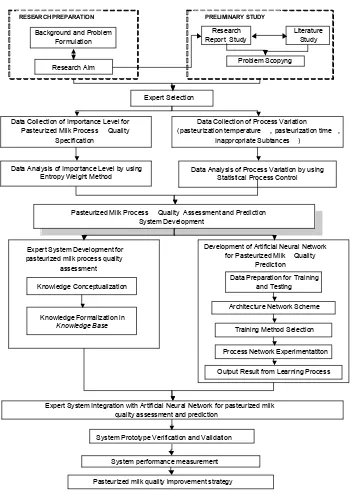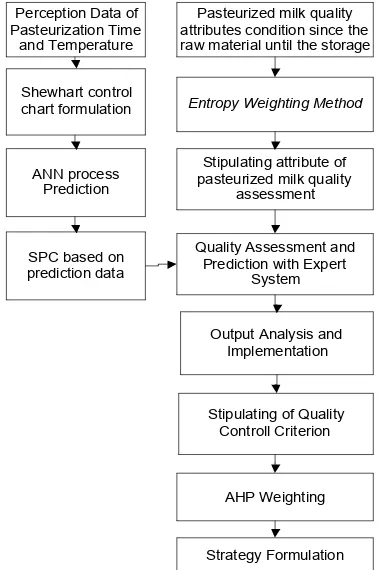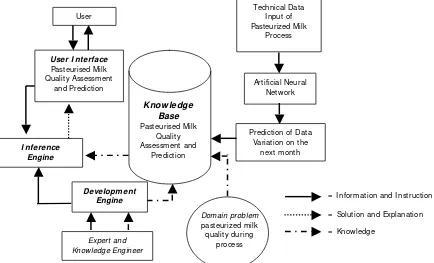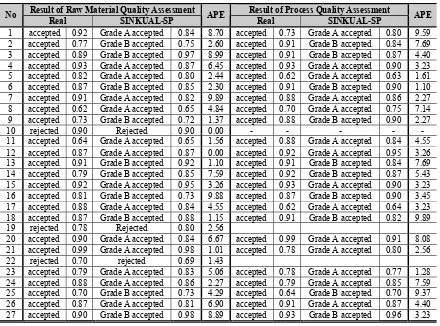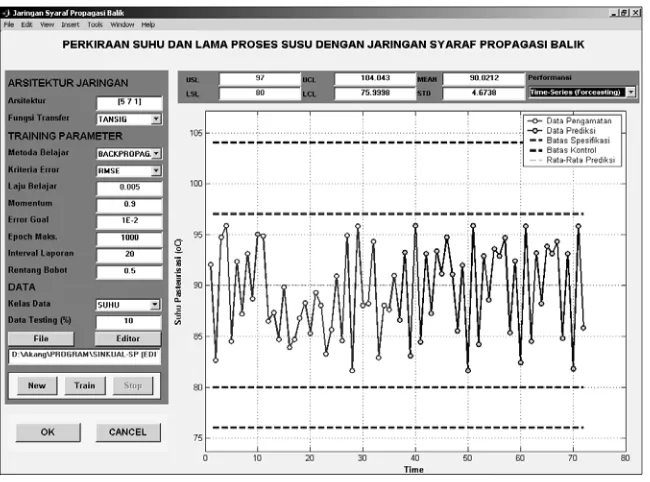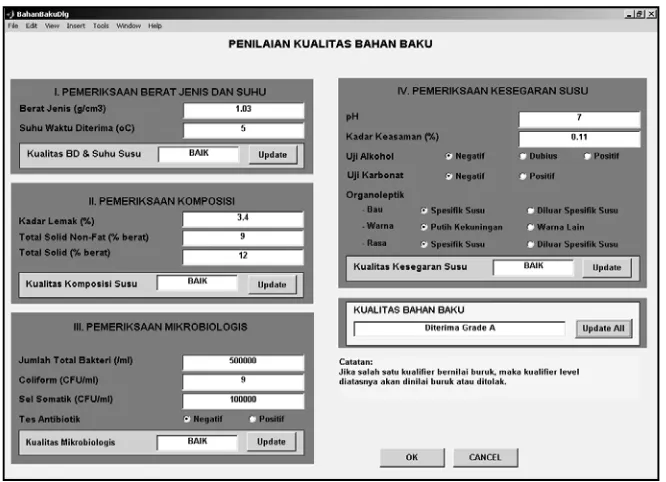Marimin1, Winnie Septiani2, Sukardi1 and Tatit K. Bunasor1
1
Department of Agroindustrial Technology, Faculty of Agricultural Technology Bogor Agricultural University (IPB), Bogor, Indonesia
Email : [email protected]
2
Department of Industry Engineering, Trisaksi University, Jakarta, Indonesia Email : [email protected]
ABSTRACT
The aim of this research was to develop an intelligent system for pasteurised milk quality assessment and prediction that could help the quality decision makers to assess and predict the pasteurised milk quality. Utilizing Expert System and Artificial Neural Network (ANN), which called SINKUAL-SP, did these analyses. The reasoning strategy used was “Forward Chaining” and the tracing method used was “Best First Search”. Certainty Factor (CF) was used for handling uncertainty.
Multi-layer neural network architecture was used. The suited activation function was Sigmoid Bipolar, which gave the best performance network with learning rate 0.005 and momentum 0.9 together with RMSE, MSE and SSE as an error criterion. The validation for neural network indicated the conformity between the output of neural network and the goal output with RMSE value of 0.0099.
The system was verified and validated by using real data collected from pasteurised milk and milk Products Company at West Java, Indonesia. In this company, the quality of fresh milk was at grade B (good), the quality of process was at grade A and the quality of packaging and storage was at grade B. This system suggested the user to always improve the quality of pasteurised milk to achieve grade A quality.
Based on the system output, quality system reconstruction was the highest priority strategy. The quality improvement system seemed to be a way to improve the process quality of pasteurised milk.
Keywords: Neural Network, expert system, pasteurised milk, quality system, soft system.
INTRODUCTION
complicated. It is not easy to solve those problems, therefore an integrated ability in various science disciplines are needed.
Most researches concerning to the milk quality were using statistical approach and were explained partially. Erwina (1987) and Karya (2001) identified the quality control parameter on fresh milk industry by application of statistical quality control. According to Mitra (1993), statistical approach in quality control could prevent deviation in processing to gain better specification. Budiarti (2002), conducted consumer perception and expectation as well as identified the dimension of importance weight of pasteurized milk quality. However, statistical approach cannot analyze total quality failure. It was limited in evaluating and analyzing parts of production. Quality improvements is much more dependant on the personnel ability in doing their analysis (Kolarik, 1995).
According to Marimin et al. (1998), expert system or intelligence knowledge based system was represent a part of artificial intelligence which enable the computer to think and make the conclusion from a group of order (ordinary order and meta order). While according to Mesker and Liebowitz (1994); Fauzett (1994); Demuth and Beale (1995), artificial neural network, one of the method in prediction, have a learning ability through practice process (training) in recognizing certain pattern and it does not need assumption about data structure, data distribution, data independency or data link. ANN has an ability to disregard the insignificant data and emphasize it at top-drawer data.
Integration of expert system and artificial neural network are expected to have combination ability in providing expert consultancy and improving the self-experience in pursuant to the process learning. By using this system, the quality improvement and control can be continuously improved.
The aims of this research were, to: (1) develop a prototype system for pasteurised milk quality assessment and prediction during the process by integrating expert system and artificial neural network, (2) measure the process performance in the pasteurised milk industry based on the built prototype system.
The scope of this research was related to pasteurized milk quality that started from quality assessment of raw material up to quality of product packaging and storing. The analyzed product was plain pasteurized milk with regular fresh milk as the main raw material. The expected benefit from this study was to help the quality decision maker in assessing and predicting the pasteurized milk quality.
RESEARCH METHODS Research Steps
This part will explain the iterative research steps. The research stages conducted includes problem identification, conceptual model development, system development and systems analysis. Scheme of the research step is presented at Figure 1.
Data Sources
The experts were selected based on their experience and educational background in pasteurised milk quality. The selected experts consisted of practitioners, industrialist, academician and also government bureaucracy at West Java and Jakarta, Indonesia.
Data Processing and Analysis
The data and knowledge collected were processes by using quality function deployment, statistical process control, artificial neural network, rule base (expert system), certainty factor and analytical hierarchy process.
Pasteurized Milk Process Quality Assessment and Prediction System Development
Background and Problem Formulation
Research Aim
RESEARCH PREPARATION
Research Report Study
PRELIMINARY STUDY
Literature Study
Problem Scopyng
Data Collection of Importance Level for Pasteurized Milk Process Quality
Specification
Data Collection of Process Variation
(pasteurization temperature , pasteurization time , Inappropriate Subtances )
Data Analysis of Importance Level by using Entropy Weight Method
Data Analysis of Process Variation by using Statistical Process Control Expert Selection
Knowledge Conceptualization
Knowledge Formalization in
Knowledge Base
Expert System Development for pasteurized milk process quality
assessment
Data Preparation for Training and Testing
Architecture Network Scheme
Training Method Selection Development of Artificial Neural Network
for Pasteurized Milk Quality Prediction
Process Network Experimentatiton
Output Result from Learning Process
Expert System Integration with Artificial Neural Network for pasteurized milk quality assessment and prediction
Pasteurized milk quality improvement strategy System performance measurement System Prototype Verification and Validation
RESULT AND DISCUSSION
Attributes of Pasteurised Milk Quality Assessment
Compilation on the attributes of pasteurised milk quality assessment and prediction was conducted based on national quality standard in industry (Eckles, Combs and Macy, 1984; Juran, 1995; Gasperz, 1997), HACCP (Hazard Analytical Critical Control Point) (Hall and Trout, 1968), and expert knowledge. Attributes used in this system were:
(1) Raw material quality attributes, which include: a. Specific gravity and temperature at accepted time
b. The composition of fresh milk, consisted of fat rate, total solid, and total solid of non fat substances
c. The freshness of fresh milk, consisted of pH, acidity, alcohol test, carbonate test and organoleptic attributes (colour, aroma, taste)
d. The fresh milk microbiology consisted of sum of total bacterium, coliform, somatic cell and antibiotic test.
(2) Process quality attributes, which include:
a. Quality characteristics, consisted of temperature, fat rate, total solid, total solid of non fat substances, organoleptic attributes (aroma, colour, taste), phosphate test, sum of bacterium, sum of coliform
b. Process critical point, consisted of prediction result on pasteurisation temperature and pasteurisation time by using Artificial Neural Network, temperature of refrigeration and homogenisation.
c. Sanitation attributes, consisted of worker sanitation, column sanitation, environmental sanitation and equipment sanitation.
(3) Packaging and storing quality attributes, which include:
a. Packaging quality attributes, consisted of the assessment on leakage resilience, adhesive power, hygiene and packaging strength
b. Storing quality attributes, consisted of the storage time and temperature.
The framework of the quality attributes assessment and prediction is presented at Figure 2.
Conceptual Model
Intelligent System for pasteurised milk quality assessment and prediction was designed and developed in a system called SINKUAL-SP (Intelligent System for Pasteurised Milk Quality Assessment and Prediction). Figure 3 shows the model framework.
five models, namely: raw material quality assessment model, process quality assessment model, packaging and storing quality assessment model, Statistical Process Control (SPC) model and quality prediction model.
PASTEURI ZED MI LK QUALI TY ASSESSMENT
AND PREDI CTI ON SYSTEM
PREDI CTI ON TECHNI CAL
ASPECT
RAW MATERI AL QUALI TY ASSESSMENT
PROCESS QUALI TY ASSESSMENT
STORAGE PRODUCT QUALI TY
ASSESSMENT
PASTEURI ZATI ON TEMPERATURE PASTEURI ZATI ON TI ME ASSESSMENT
FUNDAMENTAL ASPECT
National Quality Standard I ndustrial Quality
Standard QUALITY STANDARD
OF FRESH MILK QUALITY STANDARD
OF FRESH MILK MICROBIOLOGY CRITICAL POINT DURING PROCESS QUALITY CHARACTERISTIC Pasteurization Process Homogenization Process SANITATION STORAGE TEMPERATURE STORAGE TIME PACKAGING Packaging Type Sterilized Packaging Refrigeration
I NAPPROPRI ATE AMOUNT WI TH FDA
Worker Sanitation Building Sanitation Tools Sanitation Environment Sanitation
Figure 2. Attributes of Pasteurised Milk Quality Assessment and Prediction Pasteurized milk quality
attributes condition since the raw material until the storage
Entropy Weighting Method
Stipulating attribute of pasteurized milk quality
assessment
Quality Assessment and Prediction with Expert
System SPC based on
prediction data Perception Data of Pasteurization Time and Temperature Shewhart control chart formulation ANN process Prediction
Output Analysis and Implementation
Stipulating of Quality Controll Criterion
AHP Weighting
Strategy Formulation
System Design
SINKUAL-SP processing stages were divided into four steps: input process, prediction process, assessment process and output process. The schema of integrated process utilizing expert system and artificial neural network is presented at Figure 4.
Figure 4. Schema of Integrated Expert System and Artificial Neural Network
The tested activation functions were Sigmoid Bipolar (Tansig), Binary Sigmoid (Logsig) and Linear. Based on the trial and error, activation function that gave the best network performance was the Sigmoid Bipolar with learning rate of 0.005 and momentum of 0.9 with RMSE value 0.009959, MSE value 0.009999 and SSE value 0.009950. ANN validity was observed according to network output and goal output. The ANN structure used in this research is presented at Table 1.
Table 1. ANN Structure Used in this Research
Characteristic Specification
Sum of input unit 5 units Sum of hidden unit 9 units Sum of output unit 1 unit
Weight Initialisation Nguyen Widrow Activation Function Sigmoid Bipolar
Tolerance 0.01
Accelerate Study 0.005
Sum of epoch 1000
Momentum 0.9
Domain problem pasteurized milk quality during
process
= Solution and Explanation = I nformation and I nstruction User
User I nterface
Pasteurised Milk Quality Assessment
and Prediction
I nference Engine
Development Engine
Expert and Knowledge Engineer
Know ledge Base Pasteurised Milk
Quality Assessment and
Prediction
Technical Data I nput of Pasteurized Milk
Process
Artificial Neural Network
Prediction of Data Variation on the
next month
Using real data collected from dairy product industries tested the system performance. The result of Absolute Percentage Error (APE) of the assessment between the real output and the system output is presented at Table 2.
Table 2. The Absolute Percentage Error (APE)
Result of Raw Material Quality Assessment Result of Process Quality Assessment
No
Real SINKUAL-SP APE Real SINKUAL-SP APE
1 accepted 0.92 Grade A accepted 0.84 8.70 accepted 0.73 Grade A accepted 0.80 9.59 2 accepted 0.77 Grade B accepted 0.75 2.60 accepted 0.91 Grade B accepted 0.84 7.69 3 accepted 0.89 Grade B accepted 0.97 8.99 accepted 0.91 Grade B accepted 0.87 4.40 4 accepted 0.93 Grade A accepted 0.87 6.45 accepted 0.93 Grade A accepted 0.90 3.23 5 accepted 0.82 Grade A accepted 0.80 2.44 accepted 0.62 Grade A accepted 0.63 1.61 6 accepted 0.87 Grade B accepted 0.85 2.30 accepted 0.91 Grade B accepted 0.90 1.10 7 accepted 0.91 Grade A accepted 0.82 9.89 accepted 0.88 Grade A accepted 0.86 2.27 8 accepted 0.62 Grade A accepted 0.65 4.84 accepted 0.70 Grade A accepted 0.75 7.14 9 accepted 0.73 Grade B accepted 0.72 1.37 accepted 0.88 Grade B accepted 0.90 2.27
10 rejected 0.90 Rejected 0.90 0.00 - - - -
-11 accepted 0.64 Grade A accepted 0.65 1.56 accepted 0.88 Grade A accepted 0.84 4.55 12 accepted 0.87 Grade A accepted 0.87 0.00 accepted 0.92 Grade A accepted 0.95 3.26 13 accepted 0.91 Grade B accepted 0.92 1.10 accepted 0.91 Grade B accepted 0.84 7.69 14 accepted 0.79 Grade B accepted 0.85 7.59 accepted 0.92 Grade B accepted 0.87 5.43 15 accepted 0.92 Grade A accepted 0.95 3.26 accepted 0.93 Grade A accepted 0.90 3.23 16 accepted 0.81 Grade B accepted 0.73 9.88 accepted 0.87 Grade B accepted 0.90 3.45 17 accepted 0.88 Grade A accepted 0.84 4.55 accepted 0.62 Grade A accepted 0.64 3.23 18 accepted 0.87 Grade B accepted 0.88 1.15 accepted 0.91 Grade B accepted 0.82 9.89 19 rejected 0.78 Rejected 0.80 2.56
20 accepted 0.90 Grade A accepted 0.84 6.67 accepted 0.99 Grade A accepted 0.91 8.08 21 accepted 0.99 Grade A accepted 0.98 1.01 accepted 0.78 Grade A accepted 0.80 2.56 22 rejected 0.70 rejected 0.69 1.43
23 accepted 0.79 Grade A accepted 0.83 5.06 accepted 0.78 Grade A accepted 0.77 1.28 24 accepted 0.88 Grade A accepted 0.86 2.27 accepted 0.79 Grade A accepted 0.85 7.59 25 accepted 0.70 Grade B accepted 0.73 4.29 accepted 0.64 Grade B accepted 0.70 9.37 26 accepted 0.87 Grade A accepted 0.81 6.90 accepted 0.91 Grade A accepted 0.87 4.40 27 accepted 0.90 Grade B accepted 0.98 8.89 accepted 0.93 Grade B accepted 0.96 3.23
System Implementation and Testing
The aim of SINKUAL-SP implementation was to know how far the system designed could be implemented, to fulfil the specified criterion and to know the system accuracy according to the costumer requirement. The implemented system tested by using company actual data collected on April 2005. System testing were using four data groups, namely:
1. Actual data for raw material quality assessment 2. Actual data for process quality assessment
3. Actual data for packaging and storing quality assessment
4. Temperature and pasteurised time actual data for quality prediction
is either A or B. The grading was done based on the national quality as well as industrial quality standards. Grade A accepted milk indicates that the milk fulfil all the quality standard at the high level of milk quality, while grade B accepted milk indicates that the milk has fulfil the normal quality standard.
The results of SINKUAL-SP assessment to the provided data were:
1. Raw material quality : accepted in grade B
2. Processing quality : accepted in grade A
3. Packaging and storing quality : accepted in grade B.
The system also gave the suggestion to the user based on the identified quality grades. In that case, the system suggested improving pasteurised milk quality through improving raw material quality, improving packaging and storing quality while maintaining good process quality.
ANN process performance prediction output (i.e. temperature and length of pasteurisation) was shown at Shewhart control chart. An example of the prediction output is presented at Figure 5.
Figure 5. ANN Process Performance Prediction Output
System implementation and testing for the raw material quality assessment is presented at Figure 6.
Quality Improvement Strategy Formulation
Figure 6. System Implementation and Testing of Raw Material Quality Assessment
PASTEURIZED MILK QUALITY IMPROVEMENT STRATEGY
RAW MATERIAL QUALITY
PROCESSING QUALITY
PACKAGING AND STORING QUALITY
HEAD OF QUALITY CONTROL
HEAD OF PRODUCTION
HEAD OF MARKETING
HEAD OF OPERATION
BOARD OF DIRECTORS
SALES IMPROVEMENT CONSUMER SATISFACTION IMPROVEMENT
PROCESS AND PRODUCT QUALITY IMPROVEMENT
PRODUCTIVUTY AND PERSONAL COMITMENT
IMPROVEMENT
QUALITY IMPROVEMENT PROGRAM IN PSYCHO-CHEMISTRY ORGANOLEPTIC
PRODUCT DIVERSIFICATION
PROGRAM
QUALITY SYSTEM IMPROVEMENT PROGRAM
HUMAN RESOURCES IMPROVEMENT PROGRAM
MIS IMPROVEMENT PROGRAM PRODUCTION SYSTEM
IMPROVEMENT PROGRAM FOCUS
ACTOR
STRATEGY FACTOR
GOAL
Figure 7. Hierarchy of Pasteurised Milk Quality Improvement Strategy
Table 3. Weight and Priority of the Quality Improvement Strategy for Pasteurised Milk
Strategy Weight Priority
Quality improvement program: psycho-chemistry – organoleptic
0.197 2
Product diversification program 0.189 3
Quality system improvement program 0.236 1
Production improvement program 0.161 4
Human resources improvement program 0.104 6
Information system improvement program 0.114 5
CONCLUSIONS AND RECOMMENDATIONS
Conclusions
Artificial neural network and expert system could be used to develop an intelligent system prototype for pasteurised milk quality assessment and prediction. Based on the research result, it could be seen that the system prototype was able to assess and predict the pasteurised milk quality. Process conditions, i.e. temperature of processing and pasteurisation time could be predicted by using back propagation artificial neural network depicted at the Shewhart control chart.
Using actual data from milk industries at West Java and Jakarta, Indonesia tested the developed system. The system was able to assess and predict the pasteurised milk quality with considerably high accuracy. The system accuracy for raw material quality assessment was 90.11% - 98.90%.
Pasteurised milk quality improvement strategy was formulated by using Analytical Hierarchy Process (AHP). The influencing factors were raw material quality, process quality, packaging and storing quality. The highest priority actor on this strategy was the head of Quality Control. Main goal of this strategy was improving the quality product and process by doing the quality control start from the raw material until the last product, implementing the sanitation program and quality control system by using statistical quality control and analysis.
Recommendations
To improve the reliability and accuracy of the developed pasteurised milk quality assessment and prediction, further efforts should be done:
1. Expanding assessment and prediction attributes, 2. Allowing various types of pasteurised milks,
3. Elaborating the quality improvement strategy with more applicable and operational implementation guidance,
5. The representation of quality grade can be expanded, such as very good, good, normal, bad and very bad.
REFERENCES
Budiarti. (2002). Pasteurised milk quality improvement planning based on HACCP and Deming Prize. Surabaya Institute of Technology. Surabaya.
Demuth H and Beale M. (1995). Neural Network Tool Box for Use with Matlab the Math Works,inc. United State of America.
Durkin J. (1994) Expert Systems Applications in Engineering and Manufacturing. Prentice Hall International, inc. United State of America.
Eckles CH, Combs S and Macy J. 1984. Milk and Milk Products 4thEd. Mc. Graw Hill Publishing, Co, LTD. New Delhi.
Erwina. (1987). The application of quality control technique for fresh milk trading. Bogor Agricultural University. Bogor.
Fausett L. (1994). Fundamentals of Neural Networks. Prentice Hall International, inc. United State of America.
Garperz V. (1997). Quality management, Gramedia Pustaka Utama. Jakarta.
Hall CW and Trout GM. (1968). Milk Pasteurisation. The Avi Publishing Company, Inc. London.
Juran JM. (1995). Quality leadership PT Pustaka Binaman Pressindo. Jakarta.
Karya N. (2001). Quality control for pasteurized milk industry. Bogor Agricultural University, Bogor.
Kolarik WJ. (1995). Quality: Concept, Systems, Strategies and Tools, Mac Graw-Hill International Edition.
Marimin, Herlina L., Andri A., Umano M., Hatono I., and Tamura H. 1998. Expert System for New Product Strategy Development. 1998 IFIP Published by Chapman & Hall.
Mesker L and Liebowitz J. (1994). Design and Development of Expert Systems and Neural Networks, Mac millan Publishing Company.
Mitra A. (1993). Fundamentals of Quality Control and Improvement. Macmlilan publishing company. New York.
